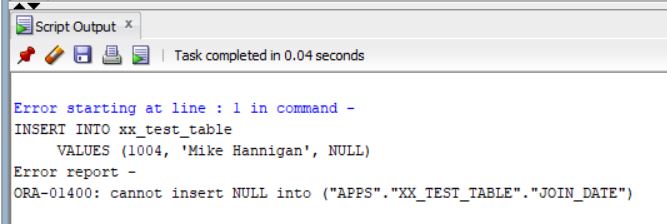The following script helps to create a Customer with basic information (mandatory information) in Oracle Applications TCA Architecture.
DECLARE
l_cust_account_rec hz_cust_account_v2pub.cust_account_rec_type;
l_org_rec hz_party_v2pub.organization_rec_type;
l_customer_profile_rec hz_customer_profile_v2pub.customer_profile_rec_type;
l_account_name hz_cust_accounts.account_name%TYPE;
l_msg_count NUMBER;
l_msg_data VARCHAR2 (4000);
l_err_msg VARCHAR2 (4000);
l_return_status VARCHAR2 (1);
l_cust_account_id NUMBER;
l_account_number hz_cust_accounts.account_number%TYPE;
l_party_id hz_cust_accounts.party_id%TYPE;
l_party_number hz_parties.party_id%TYPE;
l_cust_acct_profile_id hz_customer_profiles.cust_account_profile_id%TYPE;
BEGIN
l_cust_account_rec.account_name := 'Test Customer 98765432';
l_cust_account_rec.account_number := '98765432';
l_cust_account_rec.customer_type := 'R';
l_cust_account_rec.attribute1 := SYSDATE;
l_cust_account_rec.created_by_module := 'HZ_CPUI';
l_org_rec.organization_name := 'Test Customer 98765432';
hz_cust_account_v2pub.create_cust_account (
p_init_msg_list => fnd_api.g_true,
p_cust_account_rec => l_cust_account_rec,
p_organization_rec => l_org_rec,
p_customer_profile_rec => l_customer_profile_rec,
p_create_profile_amt => fnd_api.g_true,
x_return_status => l_return_status,
x_msg_count => l_msg_count,
x_msg_data => l_msg_data,
x_cust_account_id => l_cust_account_id,
x_account_number => l_account_number,
x_party_id => l_party_id,
x_party_number => l_party_number,
x_profile_id => l_cust_acct_profile_id);
DBMS_OUTPUT.put_line ('API Return status is: ' || l_return_status);
IF l_return_status <> 'S'
THEN
DBMS_OUTPUT.put_line ('Error message is: ' || SUBSTR (l_msg_data, 200));
END IF;
IF l_return_status = 'S'
THEN
BEGIN
SELECT account_name
INTO l_account_name
FROM hz_cust_accounts
WHERE account_number = '98769876';
DBMS_OUTPUT.put_line (
'Customer Account created with Account number: '
|| l_account_number
|| ' and Cust Account ID: '
|| l_cust_account_id
|| ' and Account Name: '
|| l_account_name);
EXCEPTION
WHEN OTHERS
THEN
DBMS_OUTPUT.put_line (
'Error during deriving Account Name: ' || SQLERRM);
END;
END IF;
EXCEPTION
WHEN OTHERS
THEN
DBMS_OUTPUT.put_line ('Error during creating account: ' || SQLERRM);
END;
The DMBS Output is shown as below:

Upon running the script above, a Customer is created. The customer can be found in Hz_Cust_accounts table.
Below is the query to check the customer and some important columns in the Hz_Cust_Accounts table.
SELECT cust_account_id,
party_id,
account_number,
status,
customer_type,
account_name,
created_by_module,
h.*
FROM hz_cust_accounts h
WHERE account_number = '98765432';

















